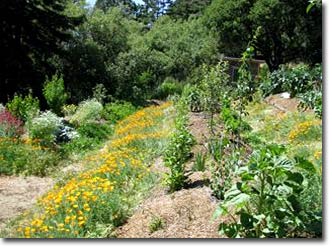
Everyday, lawns are being mowed, leaves are being raked, and people are mechanically throwing away a viable source of fertilizer while actively working against Mother Nature.
In the garden, we level the ground, till the soil, mix in some compost, and repetitively plant annual crops year after year in the hot baking sun. Every year, most gardeners rinse and repeat the same methods ensuring their fate for the next year.
Work with the Flow of Nature
Instead of mowing the lawn or tilling the soil, annual and perennial weeds cover the ground adding nitrogen and other nutrients into the soil. Shrubs then move in and shade out the weeds, and as time moves on trees slowly colonize and create a forest.
The downside is that Nature is random and chaotic. If left to work by itself, you probably won't see the forest evolve in your lawn anytime soon.
Add the Human Element and Bio-mimicry
On the plus side, we can harness this natural pattern by using biological mimicry.
Recall your high school biology class. The Monarch butterfly is poisonous and the viceroy is not. However, the viceroy has similar patterns to the Monarch which makes predators weary of eating it. Like the viceroy, if mankind observes Nature's design in creating ecosystems, we too can co-create a food forest within a few years.
The Food Forest
The life in a forest is categorized in seven categories: the over story (canopy), the understory, vines, the herbaceous layer, the shrub layer, the ground, and the rhizosphere. Even with some shade, plants thrive with the help of taller plants nursing them and you from the baking sun.
Each layer in the forest provides an opportunity to grow all life's necessities.
Start Gardening with Nature
To begin gardening with Nature can be slow process. Tackling a yard or knowing where to begin can be overwhelming. My suggestion is to draw out the final layout (in a bird's eye view) of what you would like it to be. Trees don't come that big unless you're willing to spend money; so begin retracing back how the garden would look before the trees got that big and place plants around the tree that might work well with it. Continue to do this until you have a layout or plan of what you have to work with at the moment. Keep in mind this will only give you an idea of what your garden could be. Nothing goes according to plan.
The key is to work in small steps, and don't try to do it all at once.
P.S: In later posts, we'll show you how to minimize or eliminate watering in your initial setup and more.

